#2 Getting started
No luggage
The first day in Brazil could have started better. Due to the fact that KLM told me only to pick up my luggage in Belo Horizonte, I apparently passed the mandatory customs in São Paulo and my luggage was not permitted to enter Brazil. Here I stood in the airport of Belo Horizonte, waiting at the baggage claim for a red suitcase including Dutch cheese, a mosquito net, DEET and a lot of electronics essential for the research that would arrive 4 days later. If Filipe had not helped me by approaching employees of LATAM Airlines in Portuguese, I doubt whether or not my luggage would ever have returned. Eventually on Sunday, all the equipment for the research was complete and Yvonne had arrived as well; the fieldwork could begin!
A dive into the deep
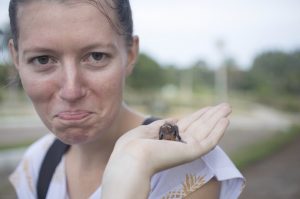
My first Lined Seedeater with its ‘sad’ face
The first day, Yvonne and I explored the field work area, our new office (see header photo), with Filipe. We caught our first birds (a canary, dove and Lined Seedeater) with a mistnet and measured young nestlings who had just hatched from the egg. With every step we took, some beautiful bird appeared and at least one of our team members would explain its Latin name and additional information. Walking with biologists is a real eye-opener. They showed us some hidden nests of the Lined Seedeater which we ourselves would probably never discover with our eyes. However, eyes are not the only sense with which you can discover Lined Seedeater. When we arrived at the most densely populated area of Lined Seedeaters, I started to practice how to record the bird song. I know that in the ‘old days’ things would probably be even more heavier, but I was surprised by the relatively heavy weight of the recorder. Nevertheless, I really looked like a field researcher now!
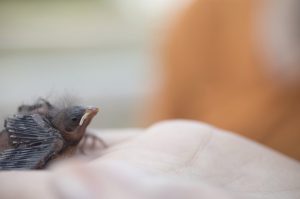
Sporophila lineola nestling
The first two days, I still practiced with recording random Lined Seadeaters and I got familiar with the sound the males make. The thought we initially had of females singing too, did not seem to be right. Therefore, I decided to only focus on male song and figure out whether there is a difference between the song complexity of black-and white males and brown males that have nearly the same plumage as females. This research might give an insight on why there are two phenotypes of males and what are the advantages of each plumage.
In full swing
These last days, I felt more and more experienced in recognizing the song of male Lined Seedeaters, reading ring colour combinations through my binoculars and noticing the pattern of their territory. Dalila, a Brazilian PhD student involved in this project, and Gustavo, a very dedicated Brazilian bachelor student which spends most of his time in the field, are the real experts of field work. Almost every day they find new nests by observing the behaviour of both male and female Lined Seedeater. I was really excited to find my first nest. It was not a nest of a Lined Seedeater though… For that I am still looking, because for every nest you find, Dalila treats you on either a chocolate bar or a beer!
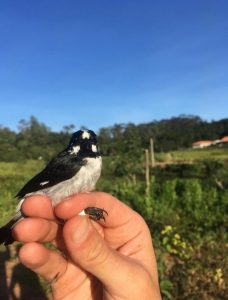
Male with black and white plumage
Together with Filipe, we created three trails through the field work area of which Gustavo and I would walk two per day. During these walks, we pass as many nests as possible. During my recording, Gustavo is able to capture the position of the male via a GPS which is important for his research. In my opinion we are a great team! Not only do I learn a lot from him about the Lined Seedeater, I also get to know everything about his way of living which is totally different compared to mine.
Schedule of the day
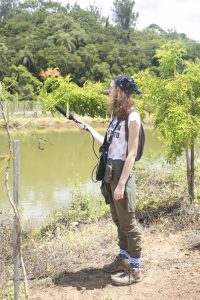
Recording outfit (socks and shirt I had to buy, because I had no luggage)
At 4:30 am, the alarm clock will go off. Dalila is already awake for half an hour to sort all the equipment out per team member. We pack our bags with electronics, a notebook and water and at 5 am, we leave the house. After a walk of ten minutes we arrive at the campus. There the whole team separates in order to install playback with either predator or control sound close to a nest. These playbacks are part of Robert’s research, but he will arrive only in the beginning of February. After installing the playbacks, I need to hurry to the start of the first trail of the day, because at 5:30 am sharp, the sun comes up and the first Lined Seedeater will start singing. Each Lined Seedeater which we come across will be studied for ten minutes and if possible recorded for approximately 3 minutes. Among others I write down its position while its singing (on top of a high tree, on a electricity wire, etc.), the time, if possible its ring colour combination and whether it is a black-and white or brown plumaged male.
Sometimes we recognise a male and know that it belongs to a nest nearby. However, most of the time the male is not ringed and that leaves empty rows in my Excel file as a result. Fortunately, sometimes we discover a few day later the nest to which that the unringed male belongs which can fill up these empty rows again.
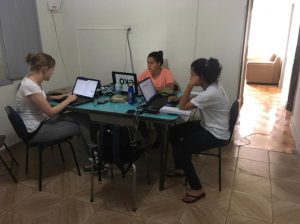
The study room where we analyse our data
At approximately 11 am we finished our two trails of the day and we return back to the house. We really cannot continue after 11 am, because of the heat. At the house I analyse my data until 4 pm. Around 4 and 5 pm, we return to the field to collect other data such as the status of each nest. Each egg or nestling in a nest is measured every day to figure out the development. At 6 or 7 pm we are done with the field work. We eat our dinner at the house and around 10:30 pm we close our eyes until the alarm clock of 4:30 am starts again.
A break
The team organizes many cool things beside the field work. We already had a journal club, a night of guitar playing and singing while eating really good food made by Leo, the other head of the research who has arrived at the project a few days ago.
Of course we cannot continue with this 6 hours of sleep every day of the week, so on Monday, Yvonne and I have claimed our free day. Today, while I am writing this blog, it’s also Monday and I slept for 13 hours to catch up with some sleep. Later today we will go out of the house to discover the town we are living in; Florestal.
Next week
Next week I will explain you how to analyse a recording of a Lined Seedeater and how the house is running after the arrival of our third Dutch team member: Tessa. Also we are organising a Tea Cup Club for next week to improve the English language skills of our Brazilian team members. To be continued…


Het is net of we in je rugzakje meelopen!
Very nice Blog!! Good luck with the hard work!!
Echt heel leuk Melindy!
Verheug me op het vervolg!
Een goede en leuke impressie van jullie bezigheden in èn buitenshuis.
Mooi Melindy, dat we zo met je kunnen meelopen. Heel interessant!
I am enjoying your blog! You are in good hands with Filipe at the lead. I wish you and your team much success in your studies.